C.A.A. Savastano's Blog, page 5
January 15, 2021
The Casebook of C.A.A. Savastano: No. 1 "The Case of the Seven Trophies"

This is a summary is part of my seven-year chronicle that exposed dozens of dishonest and jealous people on both sides of the JFK assassination case that manipulated events to cause disruptions and thwart my research but failed every time. It reveals many helped mythmakers like Judyth Baker block progress and subvert unity among those scholars involved potentially for decades that led often to needless conflict and pointless arguments. Recently I proved that cells in five different countries matched a group created by James Angleton in the nineteen sixties called CAZAB, now referred to as Five Eyes. Five countries include nearly every person attacking me emerges from, it is highly improbable this is just dozens of coincidences, thus, Canada (a cybersecurity specialist focused on stopping the penetration of official information, Trish Fleming), America (a book house disinformation by the score, Trine Day, and false researchers creating decades of confusion, James DiEugenio and Lisa Pease), Zealand (New Zealand, Frankie Vegas or someone else there), Australia (The ROKC), Britain (Bart Kamp and Dealey Plaza UK), C,A,Z,A,B. CAZAB, now Five Eyes. Someone called me paranoid once, their mistake.
It was their shortsighted and prideful nature kept them busy striking at others making real progress and kept them staring at blurry pictures of the Prayer Man myth and obsessing over me for years. It began prior when I disagreed with Greg Parker, Lee Farley, Hasan Yusef, Robert Morrow aka Andrea Skolnick, Bart Kamp, Johnny Hartley, Stan Dane, Arjan Hut, David Turner, Lancelot Uppercut (anonymous account likely one of them), Gayle Nix Jackson, Mark A. O’Blazney, Mick Purdy, Terry Martin, Paul McGurkenfarklel, Tim Fattig (former member of my research group), Trish Fleming (former research group member), Zach Jendro (former research group member), Charles Cliff (former research group member), and various other members of the Re-Open the Kennedy Case Forum (ROKC) about the blurry picture and lack of evidence which is the Prayer Man myth. Among these who began to attempt to attack and subvert me were James DiEugenio and Lisa Pease that sit as the unimpressive mentors to the rest of them and have wasted decades of our time as well.

Johnny Jartley another ROKC minon that chased me at Duncan MCrae’s Forum as they Later Did at the Education Forum because they were obsessed.

The Plot by the ROKC to Attack me and Stop me in the Education Forum from destroying their Prayer man myth. Since they have no ecidence all they could use against me was lies while attacking me in hopes to block the Facts.
They sought to prevent me from containing and debunking their Prayer Man myth, foolish theories, and unproven nonsense. They were upset by others making progress beyond them, and they were lazy dullards crying at those leaving them behind after they failed to be reasonable and transformed into a cult like group. Similar to forlorn lover, they began a six-year string of attacks on me in various forums online and were constantly obsessed with me and the facts I presented against their nonsense. This summary which shall be expounded upon in a future book reveals how I caught seven people attempting to entrap me but they inadvertently revealed themselves to me. Four in one place at one time and three later that I realized afterwards, yet each is an improbable contact that led me to apprehending all of them and exposing the plot.
The first major clue of something amiss was an appearance by Marshall Rodney Evans, Robert Groden’s partner asked me for a picture with him. Yet he did not desire a normal one, I take many of those, no he wanted me to take an old-fashioned handshake politician shot, like he was my friend or in politics, it seemed another trophy, he had fooled me or so he thought. This of course stuck out in my mind, truly a mistake as we can observe. He “befriended” me years later yet failed to realize he walked into a trap which I had waited years to spring and capture him and as many deceptive people as possible. He obliged and delivered Pease and DiEugenio plus five others to me and thus, a first trophy revealed him, one of five.

A picture used by RObert Morrow with his false character Andrea Skolnick that did not exist and was a manipulative tool that Morrow created to render discord.
The mythmaker Robert Morrow aka Andrea Skolnick (a false identity he used). I was able to detect his deception after comparing several statements from Morrow and his alias which cannot be hidden such as word choices and writing style that no one might fully hide. Further notable was “Andrea’s” repeated mentions and complaints about Roger Stone, that Morrow worked with prior and this might imply Morrow used her to generate interest for Stone as well. Stone from my research into him loved any kind of press and relished media infamy, including bad press or mentions that “Andrea” did almost daily. Andrea was constantly battling with me in groups using the same nonsensical approach that matched the exact style of Morrow but I was unsure for a time and believed she might Judyth Baker, based on common personality traits. Quite the sad person who must change sexes just to keep looking at me or undertake such nonsense, he needs mental help and a hobby.

A conflict between Reliable PRo-Commission Researcher Steve Roe, WHom I credited with helping PRove a conspiracy, even though we disagreed. His evidence aided me and I credit anyone that does. As you can see morrow is Vulgar and Deranged with a constant mention of Roger Stone, This is just like Andrea Skolnick’s Stone obsession and is one of many traits that reveals Morrow is Skolnick.
Morrow and I had tangled in related groups over his nonsensical prattle and he hated me with a passion, I largely disliked him and ignored his antics because he was unimportant to me. Strangely, Morrow shambled his way around drawing attention to himself and he circled my table at the JFK Lancer 2017 Conference and took one of my books from the sales room and brought it to me to sign it. This was perhaps his largest related mistake, if he truly hated me or disliked me as I did him, he would have ignored me as I did him. Yet this act revealed he was deeply interested in getting my attention without realizing I knew he was doing so. He obviously wanted to get a book signed by me from an undeclared reason. When my book ended up vanishing, multiple witnesses saw him leave with the book and he never paid, thus stole it. I promptly realized he had made the appearance to get a trophy, the second of five.
It was far later when I realized in the same two-hour timeframe a friend of mine, John Newman, had his phone stolen at the conference. I assumed that it may have been to get his contacts that someone present may have desired, since Judyth Baker had a simultaneous conference elsewhere in Dallas I considered the possibility she had dispatched minions to grab items at Lancer. It was years later it occurred to me Morrow is connected to JVB. I know he got my book and what are the odds another item of related importance from a good researcher would be stolen by a different person in that small timeframe? Highly improbable, yet that was my clue of trophy gathering. This was another clue to the deception they left unintentionally that in time became clear to me.

The CAPA Advertisements in 2017 for Judyth Baker’s conference at the CAPA webpage, Two leaders in CAPA are Lisa Pease and James DIeugenio.
The next sign was Jimmy DiEugenio heckling my speech at the 2017 Lancer conferences at the Adolphus Hotel, as he had the year before, because he was jealous of my useful award-winning research compared to his usual rehashed nonsense from decades ago. Thus, he desired also desired a trophy by disrupting my speeches but he did not and revealed his malice by doing it twice, this established a pattern of childish attacks and marked him to me. It made him stick out in my mind more than his wholly inappropriate sweat suit ensemble, I like to call him the Sweat suit King and Lisa Pease his constant companion is his Lady of the Fake. Thus, knowing he was a mentor to some in the ROKC that I encountered in my past time there it established a remote possibility of more than just him being persistently childish. That same year I had prior noticed well know JFK groups with Jim DiEugenio, Lisa Pease, and Robert Groden helped advertise JVB’s conference and it linked them. Now we have three trophies, and thus possibilities of collusion began to distinctly form.
Next was Glenn Viklund, perhaps the most curious of all the connected people, a supposedly “pro-commission” person that knew John McAdams, but he came to JFK Lancer, pro conspiracy, strange. He flew from Sweden and had for years fashioned himself the opponent of Judyth Baker, however so had others that aligned with her as well. He told me the journey was expressly to see me, stranger, we had never met but subsequently he asked DiEugenio to take a picture of us after he stated hating DiEugenio. Yet if he hated him then he would not have asked, you do not associate with people you hate, you stay away. Thus, he did not hate him, add that to the picture, my book stolen by Morrow, Newman's phone for JVB, and DiEugenio heckling and associated equals possible conspiracy. Yet there were more trophy seekers.
Trish Fleming was a former member of my research group I expelled for serving the conspiracy of dullards against me led by the ROKC and the other Judyth Baker aligned minions. Trish who I once told that she was more intelligent than me had decided in the time after the other trophies had been collected to ask if I would provide her a reference to a new job. She was not wholly clear on the nature of the job but stated I was the best researcher she knew. I was flattered of course but it was quite odd, she was not aware of my true level of intelligence since I was concealing it then and only had my high school diploma with a couple years of college. She was unaware of the tens of thousands of books and official files I had read, and thus why ask someone like me to provide a reference? Unless you wanted a sample of my writing to analyze. Additionally, the “best researcher” line was seemingly a lure to flattery and meant to entrap men into writing a letter, I did, but soon knew this was a fifth trophy. I looked into the job and found she was now employed by a cybersecurity firm doing “penetration testing” to surveil hackers and possible threats to official groups, like me, and perhaps was seeking to provide information about me or there was some assignment to surveil me, as the CIA has repeatedly and failed. Thus, a trophy from a person working for a business surveillance group, and that similar firm wholly fit the prior pattern.

Charles Cliff, a security guard, whom I think of as a wannabe Lestrade, that gave me leadership in a nonsense group with a handful of people, because he believed that he could emotionally manipulate me to make him the administrator in my group of hundreds. I of course indulged his belief that he was crafty and made him an administrator to prove he was safe and could fill the group with lemmings I could catch in one fell swoop and make feel secure he had got the better of me, wrong again. He assumed per usual they possessed a superior position and could take my group as I had prior taken it from Ralph Cinque, a dullard that believes in a former most popular blurry picture idea Doorway that preceded the Prayer Man tripe. I blocked and removed him and then purged their corrupt influence as they prior hoped to do so with my useful information. Yet they only had strategy, a poor one, and I possessed better strategy and tactics. Strategy requires ideas but tactics require observation, and they have none. Thus, another trophy attempt, the sixth one.
The final trophy is a disturbing look into the twisted mentality of several ROKC members. As some may know the only members of my small media group are Chuck Ochelli, Mike Swanson, Rob Clark, and myself. It used to include Trish Fleming, Charles Cliff, and Tim Fattig, who all were members of the ROKC as well. I decided months ago I would remove inactive people (Trish, Zach, Charles, and Tim) I spoke with Tim first and strangely he wanted to remain, even as an inactive. His strong desire of course struck me as odd, if he wanted to remain it would stand to reason he would contribute. Since he rarely did it lead me to ponder why he wished to stay. I began to deduce his reasoning was similar to that of the prior trophy seekers and this was a chance to spy on me. I soon realized how long Tim, Trish, Zach, and Charles were aligned with the network. This led me to consider the many disturbing implications.
Several implications soon clarified as I realized how deeply each had corrupted aspects of the JFK community. Among Tim’s despicable actions were aiding “Andrea Skolnick” aka Robert Morrow in defrauding the public with a tale that “Andrea’s” house burned down and Tim supposedly made a large donation. However, my suspicions about Robert Morrow being Andrea became proven it allowed me to deduce that Tim was in league not with Andrea but whomever portrayed her. He participated in a fraudulent money drive seeking to raise money for this farcical disaster that no one endured. One episode included Greg Parker, the “leader” of these rabble, using his children as the supposed “victims” of an attack by the JVB network called Rey Rey Rey, a fake account, probably Parker himself. He used his children to generate sympathy for himself and likely attention for his book, he is a disgusting individual that was still whining about me years after I left from jealously and likely because of his lesser intelligence. He additionally has been defending
Thus, seven people attempted to make a trophy of me but instead I made trophies of them and they each led me to a greater plot against me and the entire JFK research community that includes the ROKC, Members of CAPA, pro-Commission people, and even some officials simultaneously that led to Five Eyes. Some are plants that have caused intentional damage and confusion among the community on both sides to serve personal, business, and official purposes. I have no issue with officials if they leave me and the case alone, it is over, it is conspiracy and we should all work toward the historical truth, if they actually value truth. However, based on evidence and the position I now have the mythmakers in such games are soon over, but that is another story. A story which shall continue until all of them are exposed and the public has fair chance at learning the truth of the case.
Sincerely,
C.A.A. Savastano
November 10, 2020
The Death of Stalin with C.A.A. Savastano
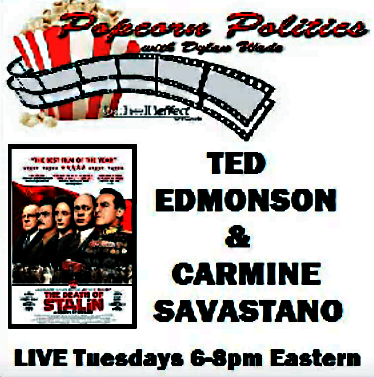
In these stressful times you are invited to a recent interview that looks at the gallows humor historical classic “The Death of Stalin”. Featuring a talented cast that includes Steve Buscemi, Simon Russell Beale, Paddy Considine, Rupert Friend, Jason Isaacs, Michael Palin, Andrea Riseborough, Paul Whitehouse, and Jeffrey Tambor.
October 3, 2020
Fact, Film, and Historical Fiction Triple Feature

You are invited to a three shows featuring discussions about sinister history as several inspect the evidence, artistic value, and the many contradictions of a famous leader. Three recent shows each with evidence and analysis for your review.
For those with a taste for debunking official and public myths: JFK Myths 16
For those who favor a discussion of film: Shining Lights Different Democrat
For those who choose disturbing history: Jefferson’s History Current Mysteries
September 6, 2020
Human Oppression Across the Ages
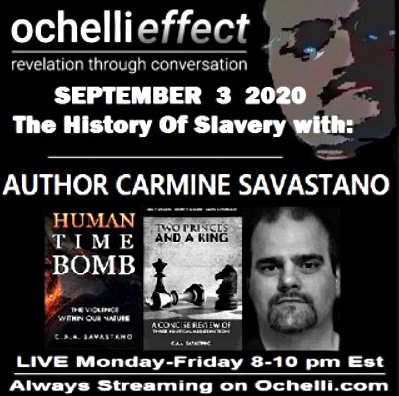
Join your host Chuck Ochelli and C.A.A. Savastano to discuss some periods of human slavery that extend thousands of years back to Ancient Sumer and have journey across time and nearly every nation to still plague humanity in present forms.
August 11, 2020
A Brief History of North American Slavery II

King Charles the II of England Is Pictured being presented An Imported PINEAPPLE by the kneeling Royal Gardener John Rose
Part II: The Imperial Expansion and the English
The first article of this series offered substantial evidence that slavery was not begun in lands which became the United States during 1619 and that it was established not by England or later American colonists but existed before Europeans arrived only to be perniciously adapted by varying imperial powers over a century earlier. Among the overlooked facts is that slavery was ongoing for centuries prior to the usual four hundred years that some claim. North America represents a minor portion in the greater history of using illegal captive human labor and slavery was not “unique to the United States, it is a part of almost every nation’s history, from Greek and Roman civilizations to contemporary forms of human trafficking.”i A largely misunderstood issue by some who discuss the matter of slavery is how common the practice quickly became due to its use by nearly every culture in North America. Its tribal roots shifted into a feudal and subsequently imperial system that empowered those using people’s fear and disgust of others against them only to render financial value at the cost of human freedom. Past tribal bondage was transformed into the legalized Portuguese enslavement of Native Americans and Africans while the Spanish crown expanded these practices with help from ongoing religious and public support.
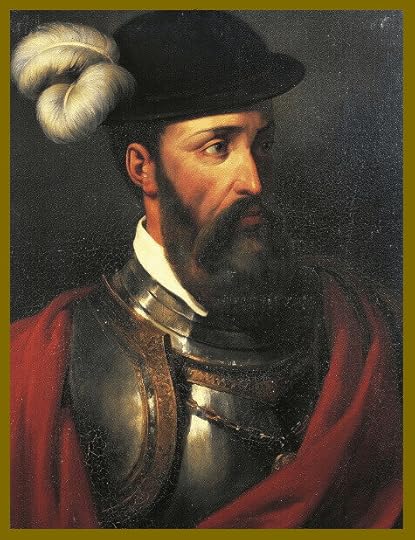
Spanish Conquistador FRancisco Pizzaro was responsible for ordering the Last Inca Emporer AtAhuallpa strangled by his troops which ended their Free civilization
The University of Houston offers that of the estimated ten to sixteen million Africans that lived to reach the New World “over one-third landed in Brazil” with other accounts placing that number as high as half of all slaves but multiple sources agree by the end of Spanish domination almost two-thirds of all slaves were in Brazil. A domination that was begun to feed the Spanish royalty’s “insatiable lust for gold” and spurred many conquistadors to expand the Spanish Empire.ii While some believe that later slavery was more harsh than Spanish practices this fails to account for no guaranteed legal protections, rampant abuse or murder of countless native slaves, and that death rates for Caribbean slaves far exceeded any later form of the infernal practice.iii The West Indies which included slave populations held by multiple imperial powers including the Spanish accounted for eighty to ninety percent of the local population, higher than any other modern society in history. While the Spanish were prodigious slavers, they also when the chance presented itself to Native Americans were enslaved as well. The tale of the Estevanico a baptized Moroccan native slave of the Spanish Conquistador Andres Dorantes de Carranza recounts a disastrous journey into New World Florida during 1528 that ended with most who survived becoming prisoners and slaves to local Native American tribes. Following their later escape from slavery Estevanico became the scout to another Spanish expeditionary party seeking to locate indigenous tribes but was killed during one such journey by arrow fire that resulted according to one conquistador for his “cruelties and assaults on Indian women”.iv Nevertheless the Spanish were just one of multiple nations to use the slave trade and many focus just on later nations.
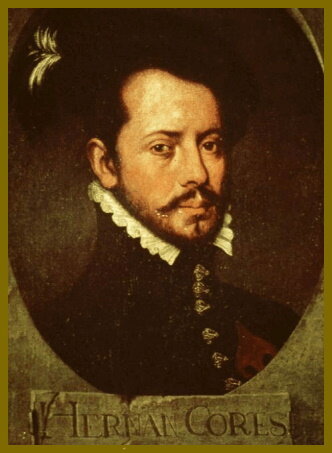
Spanish Conquistador Hernan Cortes was responsible for the conquest and destruction of the Aztec Empire
Among the worst historically verifiable evolutions in the practice of North American slavery began with the mass use of abuse, theft, rape, and genocide to dehumanize generations of indigenous cultures and Africans by slavers and conquistadors. Yet Portugal and Spain’s domination of the slave trade was quickly challenged by other European powers. Some foreign nations predictably attempted like Spanish religious leaders to delude themselves into thinking they were saviors. Their assertion seems to be that using religion or the state to justify incomprehensibly vile acts in the name of gaining wealth and power for themselves is justifiable because they considered those oppressed not as worthy. The utter lack of self-awareness and considerable malice required to embrace these ideas is apparent, yet such ideas had been widely embraced for over four millennia among most nations across the globe. The problem is consequently more profound and the origins so widespread that slavery likely even precedes humanity’s ability to write over seven thousand years ago. The ancient origins of human oppression were adopted from culture to culture and became an ever more toxic practice.
Until roughly the sixteenth century the majority of most nations supported or practiced slavery including the leaders of societies, religions, eminent intellectuals, storied philosophers, and every manner of person besides slaves themselves or their families. The English like most imperial powers had an idealistic vision of its desires to dominate others and prosper from the trade its rivals had created. Similar to other nations the leadership of England sought to justify its adaption of slavery in terms that would be palatable to many of the English public. Some leaders and intellectuals suggested they might “free” the Native Tribes from Spanish domination and find a useful pool of willing subjects to help build a larger British Empire. Conversely, few if any would ever do so and opted instead to enslave Native and later African populations just as the Spanish and Portuguese had. Notably the power of any imperial crown was vested by most international traditions, legal decrees, and enjoyed religious support almost universally in some form.
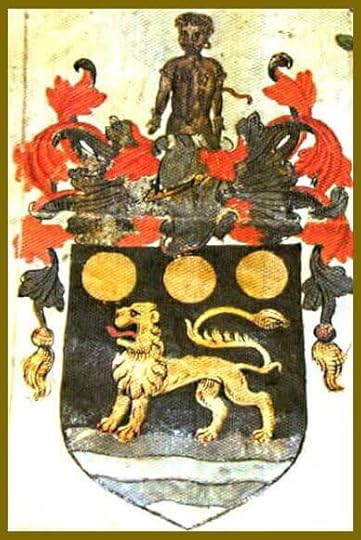
Sir John Hawkins was granted a Coat of Arms by the english crown that contained a Slave because of his slaving trips to the Caribbean
John Hawkins is reported by the English National Archives to be “considered the first English slave trader.” He was noted to make repeated slaving voyages during the 1560s to Spanish held islands in the Caribbean until his final “disastrous voyage”. A competition between Portuguese, Dutch, Danish, Swedish, Spanish, and English merchants to control the supply of “ivory, gold, pepper, dyewood, and indigo” by utilizing armed settlements in West Africa eventually would lay the foundational requirements to propagate the transatlantic slave trade. However, in this period most of the workers located within English colonial holdings were not slaves but indentured servants. These “servants” were largely the charge of the person who held a contract that on average reportedly lasted about five years.
The practice of indentured servitude that was usually willing but forced on some people was akin to several aspects of slavery but was not modern slavery as some assert. While a slave had no rights in multiple societies most indentured servants possessed legal protections that could not be denied based on the terms of the contract they undertook. As a subject of the crown they were literally part of its dominion and to seriously harm them broke the laws of the crown which subjected the contract holder to at least immense fines or restitution. What some do not understand is the level of poverty for most within imperial nations was so profound and the opportunity of the average peasant so limited they instead opted for servitude in a far-removed land because this was a chance for advancement they never would possess in the Old World. “The timing of the Virginia colony was ideal. The Thirty Year’s War had left Europe’s economy depressed, and many skilled laborers were without work…this explains how one-half to two-thirds of the immigrants who came to the American colonies arrived as indentured servants.”v
Most arriving to the New World did not arrive legally free but possessed the same desire that has driven countless groups of people over centuries to the New World to seek opportunity denied in Europe. While based on endless accounts it was demeaning, brutal, unfair, and they could be subject to violent, unreasonable, and disgusting people holding their contracts these servants would be free one day by law. Additionally, many servants were able to negotiate freedom dues that would grant them a stipend, gun, and land when they completed their time of indenture. No matter their origins the indentured were in nearly every case assured a date of freedom and some form of compensation. Indentured servitude was unjust and had many similarities to ancient slavery in Rome where advancement was possible, but it did not resemble the worst forms of modern human oppression.
Amid the same period indentured servants had become an expensive problem for the English and seeking to expand their influence using other means of control expanded the prior limited Spanish concept of racial differences. This occurred for several reasons but among the most significant was protecting the investment of their funds within human labor and one problem they faced was that indentured servants might emerge from any background. Due to this great variation in the types of people indentured it was much easier for someone breaking a contract to vanish within American continent’s population. Keeping track of a potentially yearly changing population in the colonies was ineffective and the contract holders possessed no assured means of locating every person or the funds to do so which rendered such contracts an increasingly expensive gamble. “As demand for labor grew, so did the cost of indentured servants. Many landowners also felt threatened by newly freed servants demand for land.” The English colonial leadership decided the solution to such problems was creating a class below indentured servants without rights based upon easily identifiable physical characteristic to prevent escape or concealment and separate them from the rest of the public.
These would-be future captors required a unifying trait that was shared largely by the people they wished to subjugate while simultaneously promoting further pseudo-scientific ignorance that painted those wielding oppression as better than people they oppressed. English supporters of slavery and religious leaders in the New World aided the expansion of a twisted concept of classifying multiple cultures into two distinct races needed for greater imperial profit. The English selected the terms black and white to encompass several cultures in the world for legal use despite the obvious nonsensical basis of such classification upon random biology. In time such arbitrary decisions would classify Native Americans as black or white based on the position of varying state and local jurisdictions with likely unimagined other future results. Nevertheless, if we consider the matter rationally, we easily can observe that people emerge from a wide array of cultural origins that no single word could accurately encompass with ease. Race was socially constructed to overcome this fact and the English law categorized slaves by decree on the basis of easily identifiable and officially disdained physical traits and thus dehumanized them. This codified immoral system was taught to future generations and with a few critical changes in English colonial law the transformation from years of servitude to lifelong slavery based on the construct of assigned race began.
Repeatedly it can be observed that slavery is not merely the chosen inhuman abuse of single nation upon one people but nearly everyone in that period were eager to use immoral domination for profit and power. If we consider the thesis of the New York Times 1619 Project, beyond the already proven inaccuracies that required them to make revisions, we can see the very foundation such ideas rely on that ignore contrary facts. Historian Adolph Reed in no uncertain terms deconstructs its original thesis by stating “The first sentence in the first essay is a lie…In 1619…African slaves showed up in North America. Back then they weren’t slaves, so it’s time to drop the curtain, pack up the props and go home…They were sold as indentured servants and served a time of indenture, and they melted into the population…and they were free.” The emergence of race theories heavily influencing substantially codified English slavery laws would not occur until the crown of England gained more legal dominance over its significantly expanded territory decades later.vi vii viii
“The concept of race as a fixed biological identity did not exist when the Europeans settled in Virginia in the early seventeenth century. The English of that era perceived the difference primarily as a matter of culture, society, and especially religion. This tendency led them to regard Indians and Africans similarly as alien peoples with an odd and unfamiliar culture and, most fundamentally, as heathens.”ix Heathens were considered by most Europeans during that period at best to be unsaved noble savages often regarded as willful children and not free-thinking individuals with natural rights if they opposed imperial rule. This distinction is paramount because the approval of most religions certainly fueled the increasingly brutal treatment of natives, servants, and slaves with a seal of religious approval. A reason why imperial founded slavery endured within later history is related to centuries of royals and churches teaching parents and subsequently children that oppression was righteous. What might a person not be capable of if they believed a god and his representatives offered support for such practices?
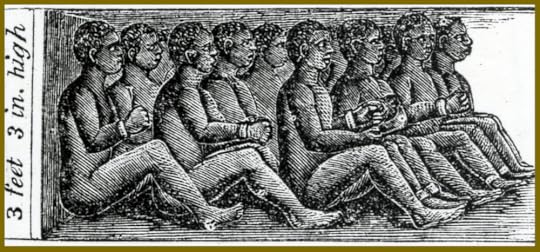
African Slaves were often transported by Imperial nations within A Ship’s Lower Hold. Enslaved people faced brutally cramped and unsanitary conditions that resulted in hundreds of thousands of deaths and survivors of this nightmarish journey became Slaves
The reduction of most indentured servitude coupled with escalating deaths resulting from disease, war, and mistreatment of enslaved Native Americans led the British slavers across the Empire to replace them with African people. Among the chief businesses engaged in the British portion of the transatlantic slave trade were speculative often rich investors. “Portugal and Britain were the two most ‘successful’ slave-trading countries accounting for about 70% of all Africans transported to the Americas. Britain was the most dominant between 1640 and 1807 when the British slave trade was abolished. It is estimated that Britain transported 3.1 million Africans (2.7 million arrived) to the British colonies in the Caribbean, North and South America and to other countries”.x Yet most of these new slaves were not sent to North America but varying locations across the globe to face usually equal abuse or death. They were captured and sent to lifelong slavery by companies who enjoyed royal trade privileges and had no modern taught compunctions about enslaving other humans.
One of the rarely known legal precedents that rendered the first black indentured servant into a slave by changing the definition legally was a case during the 1650s involving a rich man named Anthony Johnson and his African indentured servant John Casor who attempted to break his contract by escaping from Johnson’s control. "The court sided with Johnson, who claimed that Casor was his slave for life...It was a watershed moment in the history of institutional slavery" within Virginia.xi Past freedom achieved by means of religious conversion and prior contracts were denied under an intractable oppressive imperial system from which no redemption existed beyond death or escape. The blind greed of slavery can further be exhibited by studying the past of Anthony Johnson who himself was a former indentured servant from Africa. He was among the rarest of people in the Virginia colony who had worked for other colonists and later possessed a healthy tobacco farm. Eventually he bought his own servants and following John Casor’s escape Johnson acquired his first slave. He was according to a research study one of more than 3,500 free black slave owners that held from one to nine African slaves but the reasoning behind such ownership drastically varied. Reportedly a great deal of former slaves purchased family members and were using horrendous laws to enact philanthropy but this does not mean a vast majority or those like Anthony Johnson did so. It exemplifies that disregard for human rights was the motivating factor and not skin color in some pivotal cases, the common element is all types of people in North America used inhuman oppression.xii xiii

A CARibbean Slave is held and beaten by other African slaves as the English Slave owner watches the violence
The Royal African Company that was chartered in 1672 reportedly prospered amidst “speculative enthusiasm” and its greatest source of revenue was generated by the sale of humans in the West Indies. The Company was only able to ply its trade effectively because of the assurances the English royal grant of monopoly provided by King Charles the II which “held several apparent advantages…the 1672 charter barred other Englishmen from even visiting the West Coast south of Cape Blanco without permission…authorized seizure by company officials of the ships and cargoes of intruders, and arranged for their prosecution by establishing the Guinea Coast a court of judicature.” Within the colony of Virginia, the Company had at least seven agents that were deeply involved some aspect of colonial politics. Most of them held estates, wealth, status in local affairs, and even rank in the militia “including two county commanders-in-chief”.xiv Nevertheless the Royal African Company lost imperial favor and its monopoly on the slave trade during 1698. This resulted in further expanding the practice to large and small like-minded groups as the Company increased its shipments of slaves beyond the loss of monopoly over the next decade until its failure and dissolution. The international system of feudal backed enslavement with the blessing of religious leaders had been converted again into a very prosperous and diabolical business with the help of English royal and local agents.

King Charles the II of England Bestowed the Royal African Company A monopoly on the Early portion of ENglish INVOLVEMENT within the transatlantic Slave Trade
There are past similarities that should not escape our notice between the slavery in the ancient and colonial worlds. “Parallels between ancient and New World slavery abound: from the dehumanizing device of addressing men of any age as ‘boy’, the use of branding and head shaving as mods of humiliation…naming slaves, making fugitive slaves wear a metal collar, to clothing domestic slaves in special liveries or uniforms.” Most slaves in history were often assumed to be of lower intelligence, dishonest, and less worthy due to random biological circumstance, some were even told slavery was their fate set by the gods of several periods. All manner of mythical rule would emerge in later generations seeking to justify the abominable practice because perhaps deep within a few of the most ardent slavers knew the truth, it was largely a business decision based on cruel lies. It was greed and power and not any high-minded or legitimate source from which their assumed superiority emerged; no higher power granted them mastery of other people but the shifting reversals of history in which most were pawns of more powerful nations. It was ancient nefarious ideology which allowed imperial nations to justify the institution of slavery as they sought to quench the nearly ceaseless desire of humans to dominate people more effectively while profiting from it.
While other slaving companies would overshadow the Royal African Company, it faded due in part to opposing factions of “anti-Royalists and anti-monopolists”, it serves as a reasonable template to understand the imperial motivations for slavery that have been ever present. This additionally serves as potential foreshadowing to slavery’s eventual demise without royal protection because it was not efficient to generate benefits for most people in any society that included a large slave population. Any system that granted monopolies or based its foundation upon unearned royal proclamation of dominion could not hope to surpass millions of people willing to do nearly anything to earn a wage for themselves beyond the control or royal dictates. The endorsement of slavery by so many royals presents an ominous truth that many humans can believe power, wealth, or status makes them a better person. Such things make them strong, rich, and famous but they provide no assurance of their real values or worth to humanity.
Sincerely,
C.A.A. Savastano
References:
i. American slavery: Separating fact from myth, June 19, 2017, The Conversation, theconversation.com
ii. Ciara Torres-Spelliscy, August 23, 2019, Everyone is talking about 1619. But that’s not actually when slavery in America started, Washington Post, washingtonpost.com
iii. American Slavery in Comparative Perspective, (n.d.), Digital History, University of Houston, digitalhistory.hu.edu
iv. Donald E. Chipman. (n.d.), Estevanico, Texas State Historical Association, tshaonline.org
v. Indentured Servants in the U.S., (n.d.), History Detectives, PBS, pbs.org
vi. Adolph Reed Critiques The 1619 Project, May 14, 2020, The Michael Brooks Show, michealbrooksshow.libsyn.com
vii. Emily Jashinsky, May 4, 2020, A Pulitzer Prize Was Just Given To The 1619 Essay The New York Times Admitted Was Historically Inaccurate, The Federalist, thefederalist.com
viii. Michael Guasco, September 13, 2017, The Misguided Focus on 1619 as the Beginning of Slavery in the U.S. Damages Our Understanding of American History, Smithsonian Magazine, smithsonianmag.com
ix. Gregory Ablavsky, (n.d.), Making Indians “White”; The Judicial Abolition of Native Slavery In Revolutionary Virginia and Its Racial Legacy, University of Pennsylvania Law School, law.upenn.edu
x. Britain and The Slave Trade, (n.d.), The National Archives, nationalarchives.gov.uk
xi. Kat Eschner, March 8, 2017, The Horrible Fate of John Casor, The First Black Man to be Declared Slave for Life in America, Smithsonian Magazine, smithsonianmag.com
xii. Pressly, T. (2006). "The Known World" of Free Black Slaveholders: A Research Note on the Scholarship of Carter G. Woodson. The Journal of African American History, 91 (1), 81-87.
xiii. Henry Louis Gates Jr., March 4, 2013, Did Black People Own Slaves?, The Root, theroot.com
xiv. Killinger, Charles Lintner, “The Royal African Company Slave Trade to Virginia, 1689-1713” (1969). pp. 12-14
July 26, 2020
Paging Dr. Jolly West

Doctors are supposed to be healers and those who can ease human suffering, but what might occur if a doctor abandoned ethics and sought to unlock the fear and pain of damaged people by enhancing their suffering? C.A.A. Savastano and Chuck Ochelli delve into the life of Dr. Louis Joylan West and his commitment to understanding human pain and discomfort by using inhuman methods to do so often at the behest of government officials.
July 14, 2020
The Corporate Morality Mask Ripped Off

C.A.A. Savastano returns to the Wall Street Window to discuss the superficial appearance of the face offered by most corporations engaging in morality policing and the actual reasons they are likely doing so.
July 10, 2020
The Corporate Morality Mask

Several corporations have been moralizing to customers and using corporate power to censor information and influence politics in the name of better practices for quite some time. These corporations have altered their business practices to use social issues for influencing potential customers, limiting worker behavior and thought, and shaping legal policies in a psychological attempt to make customers believe a corporation has moral ethics or is worthy of emulation. This ridiculous proposition can be unmasked with every corporate spending report, do they spend most of their earnings on genuine attempts to better society for all people or do they plan events and reward loyal advocates for paying lip service to their mask of morality? Are they prone to extravagant displays of “benevolence” with media coverage and every possible manipulation of the event to advantage or do they just invest within communities without all the desired but unnecessary back patting and victory laps?
This modern commitment to public safety and a better future via censorship and demonization of opposing ideas is a well masked attempt for greater power. The value of human lives weighed by a corporation against the eventual recall of lethal products is a potentially instructive guide to the exact value corporations place upon any individual. If corporations truly cared about human lives why do they verifiably disregard them when it might harm their profits or reputation? Whether it was vehicle flaws, dangerous substances, slanderous lies, incompetence, malfeasance, or just plain greed, one behavior we can observe universally among corporations is they lie to protect their interests.i Actions speak louder than well-manicured public statements designed to evoke feelings using minimal effort. Thus, history and substantial behavior would support that corporations have ulterior motives behind nearly every action they undertake.
If actually bettering society is not the primary objective of some corporations what actually might be the reason for this modern change in tactics? “I think business has to pick up the mantle when governments fail you,” Patagonia CEO Rose Marcario told TIME…Young consumers are also more likely to patronize brands who business models claim to include social change.”ii ii iv v Thus, money, the entire reason a corporation exists and public influence which allows the expansion of corporate power are likely motives. This influence allows corporations to use social issues to mold customer perceptions by using ideology against them when benefiting profit margins. “It sometimes becomes more important to believe and to express things because they are beliefs held by my peer group, than it is to say things because we think they are true or false.”iii Yet even when a person is member of the group promoted, they can be marginalized because of dissenting views, as time proceeds the will of a corporation and its supporters might become one and the same.vi

To possibly ascertain what precisely some corporations hope to gain we must look at the most dominant social narratives present within a society the corporation might benefit from using to its purposes. One modern subject of extreme use to some business entities is based on political and social disputes within American society, just a handful of events can be used to generate long-term benefits for any corporation that manipulates them properly. The media, both conservative and liberal, often use loaded words and framing of information to prevent a neutral perspective on substantial issues and this preexisting bias potentially clouds any reader’s perception of the actual facts of the matter based on the desires of the corporation authoring it. Eventually the ceaseless production of inherently flawed information can render a calcified narrative that is prone to dismiss opposing information without assessing factual criticisms that challenge the accepted ideology. Every media source desires to present that it is credible and unbiased at every turn but the facts themselves do not support that belief. The vast majority of corporate media groups are for profit businesses, they have a clear desire to attract every possible viewer to assure continued advertising dollars. This need for profit can and regularly does overcome any ethical standards the average company once possessed just ten years ago with the accelerating influences of technology and politics. This process can in many cases harm a viewer’s sense of factual reporting based on ideological doctrines reinforced by endless confirmation bias via media sources and such methods can limit not just the consideration of new opposing facts but ideas as well.
Another potential motivation for businesses to desire the appearance of moral superiority according to reporter Matt Taibbi is using morality policing to prevent “toxic environments” and hire consultants who conduct very expensive “moral” training. “The corporation wants a gold star that it can show to the public to say that it’s fixed its problem, but it also sets up a new culture wherein essentially there is some sort of a permanent ongoing review of the entire company and that can also have utility because it’s a useful way of getting rid of troublesome employees” with internal anonymous complaints. This system easily allows the corporation employing it to remove anyone who strays from what is set up to be the moral standards, even if such a violation is fabricated by an unknown complainant for unproven reasons. He continues stating in regard to corporation’s seeking to influence social issues they are merely using superficial means to distract from the larger issue of corporations usually opposing structural reform programs that would benefit society and specifically minorities at large but cost businesses more in taxes and spending.

Unfortunately, the corporate media’s commitment to scientific facts is not as strong as many imagine, especially when those facts contend a desired political action or allows opposing ideas. We can observe the clear double standard in public reactions fueled by media sources regarding protests. While public gatherings and protests occurred for different reasons in different places, they all increase the potential infection rate of the coronavirus, a drastically increased rate from past numbers, but most only decried the protests they did not ideologically agree with and did not apply such anger toward people who politically agreed with them. Yet the result is the same for those exposed, the ideological flavor of the gathering is irrelevant to the virus, it does not care why you expose yourself and those it kills being transported from gatherings back to the innocent members of public. This evaporation of concern unless an opposing group ignored the science is telling and would support facts have become a secondary concern to many in comparison to feeling morally superior.vii viii The endless support of corporations to enable anti-scientific behavior that feels right is the essence of their public disregard for individual health and lack of commitment to uncomfortable facts.ix This can be observed in the past by reviewing corporate denials on the long-term dangers of harmful activities like smoking or drinking, environmental damage from illegal practices, and when businesses foster opposing “scientific” opinions that defy logic by means of risk denial to attack legitimate science.
Modern media corporations often provide merely tabloid style content designed to illicit the largest amount of emotion with the least amount of useful content. While indeed there are social issues of importance that should be addressed seriously with extreme care, unfortunately the best some major sources offer is a daily moralizing by use of single instances woven into a tapestry of outrage similar to an Orwellian three minutes of daily hate. We are told what hate and contempt is acceptable and under what circumstance rather than dissecting the roots of all related hate displayed and the ignorance it rests upon. This creation of people ideologically linked to business entities is a disturbing trend as some foolishly identify with institutions whose primary concern is generating money and not providing reliable information to consumers. The push by several media companies seeking to observe unacceptable behavior in almost every corner of society necessitates its creation at times whether intentional or not to continue the ideology founded upon this being the case. Facts cease to matter, the ideology becoming dominant is the primary goal and evidence not supporting it becomes sinful or morally unacceptable.x xi This high-minded stance however is not universal in its application which is displayed by CNN host Don Lemon reportedly asserting that “black lives only matter when they are taken by police”. This ideological blindness can allow opportunists using popular social justice narratives to exploit them and further allow fringe opposition groups to delegitimize reasonable dissent over injustice.xii xiii xiv xv xvi xvii xviii
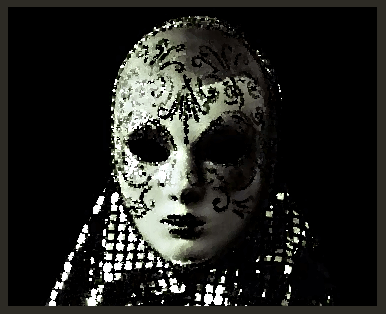
Media corporations clearly have a set ideological agenda that values people only in as much as their narrative is served by the subjects of a story. For instance, some media companies are still offering enduring coverage about a white woman who called the police falsely on a black man two months ago, this act of harassment could land the woman in jail for her false report.xix Conversely, the at least eighteen people that have been killed amid sometimes illegal and repeatedly violent nationwide protests have received no enduring coverage.xx xxi Due to the ongoing coronavirus health regulations most likely did not even receive a funeral ceremony in which all who loved them could attend, but this is not regarded as newsworthy of enduring coverage by some outlets. In this comparison we can observe that what could have occurred is seemingly more important to supposed news sources than addressing the actual murders and surrounding ongoing lethal events targeting innocent people. The idea of implied racism and a white woman lying about a black man is to some more important than white and black criminals murdering the innocent amid chaos because it damages ideological beliefs. The deaths are relegated to less consequential reporting because the larger media ideology seemingly does not care about people that do not fit their narrative of injustice.
What does this obvious disconnection from upsetting facts present of the deeper goals of related corporate media? Do corporate leaders consider that increasing public disgust in a twenty-four-hour media cycle will eventually have results beyond just increasing their viewership? I have a feeling they might be able to understand the connections between endlessly demonizing individuals in the press and growing violence between them and other groups. This is a familiar pattern because most of the existing major news, entertainment companies, and politicians from both parties spent decades offering an image of black Americans that is far different from the current one. The role such companies and people undertook in popularizing stereotypes like crack babies, super-predators, and welfare queens and the consequences of these past reports now is apparently a touchy subject.xxii xxiii xxiv xxv xxvi Perhaps those individuals they offer as the average person in any group based upon biased and even false information depending on the media source and its agenda might be part of the problem then and now. This is compounded by rich celebrities and well-placed members of the public using corporations as some variant model of behavior to impart a dangerous iconoclasm toward anything that opposes the latest ideology. This false mask of morality does not benefit the average person; however, it does conceal the reprehensible actions of several corporations who value the appearance of morality above true ethical behavior. Yet eventually all masks slip to expose what lies beneath.
Sincerely,
C.A.A. Savastano
References:
i. Charles Lewis, 935 Lies: The Future of Truth and the Decline of America’s Moral Integrity, Public Affairs, pp. 327-331
ii. Alana Semuels, November 21, 2019, Why Corporations Can No Longer Avoid Politics, Time Magazine, time.com
iii. Alyssa Rosenberg, May 30, 2019, The Myth of the woke corporation, Washington Post, washingtonpost.com
iv. Joel Kotkin, July 13, 2019, The dangerous rise of the woke corporation, Orange County Register, ocregister.com
v. Paul Tassi, July 4, 2020, Microsoft and Sony Are Suspending Facebook Advertising, But It’s Less Noble Than It Sounds, Forbes, forbes.com
vi. Fiona Smith, March 2, 2020, ‘Woke’ companies: Do they really mean what they say?, The Ethics Centre, ethics.org.au
vii. Sarah Rahal, May 3, 2018, Metro Detroit station bans Kanye songs after slavery comments, The Detroit News, detroitnews.com
viii. Berkeley Lovelace Jr., Noah Higgins-Dunn, Jasmine Kim, Will Feuer, June 2, 2020, Doctors have tips to reduce the risk of catching the coronavirus during George Floyd protests, CNBC, cnbc.com
ix. Bryan Walsh, June 10, 2020, Scientists caught between pandemic and protests, Axios, axios.com
x. Michael Powell, July 6, 2020, Are Protests Dangerous? What Experts Say May Depend on Who’s Protesting What, The New York Times, nytimes.com
xi. Michelle R. Martinelli, June 23, 2020, FBI announces noose found in Bubba Wallace’s garage had been there since 2019; no federal crime committed, USA Today, usatoday.com
xii. Bruce Haring, June 12, 2020, Jussie Smollett Judge Says No to Double Jeopardy Claims in New Criminal Charges, Deadline, deadline.com
xiii. Emma Nolan, July 7, 2020, Terry Crews and Don Lemon Clash in Heated Black Lives Matter Debate, Newsweek, newsweek.com
xiv. Kristen De Groot and Claudia Lauer, April 27, 2018, Cosby confined to his home as team decries ‘public lynching’, Associated Press, apnews.com
xv. Greg Norman, May 16, 2018, NJ school board member accused of trying to ‘manipulate’ cop, calls police chief ‘skinhead’, Fox News, foxnews.com
xvi. Dana Branham, January 24, 2019, 5 things to know about Sidney Gilstrap-Portley, the Dallas man who posed as a teen at Hillcrest High, Dallas Morning News, dallasnews.com
xvii. Walter Williams, Saturday April 11, 2020, Manipulation through racial hoaxes, Pittsburgh Tribune-Review, triblive.com
xviii. Katheryn Russell-Brown, February 25, 2019, As Racial Hoaxes Go, Jussie Smollett’s Case is a Strange One, The Atlantic, theatlantic.com
xix. Cerase, A., & Santoro, C. (2018). From racial hoaxes to media hypes: Fake news’ real consequences. In Vasterman P. (Ed.), From Media Hype to Twitter Storm (pp. 333-354). Amsterdam: Amsterdam University Press.
xx. Jan Ransom, July 6, 2020, Amy Cooper Faces Charges After Calling Police on Black Bird Watcher, The New York Times, nytimes.com
xxi. Deadly unrest: Here are the people who have died amid George Floyd protests across the US, June 8, 2020, Fox 6 News, fox6now.com
xxii. ‘Killed a baby:’ 8-year old girl killed in Atlanta shooting, July 5, 2020, Associated Press, apnews.com
xxiii. Crack Babies: Twenty Years Later, Tell Me More, May 3, 2010, National Public Radio, npr.org
xxiv. Narissra M. Punyanunt-Carter, (2008). The Perceived Realism of African American Portrayals on Television, The Howard Journal of Communications, library.uorgegon.edu
xxv. Perry L. Moriearty and William Carson, (2012). Cognitive Warfare and Young Black Males in America, University of Minnesota Law School, scholarship.law.umn.edu
xxvi. Michael Messing, October 1, 1989, Crack’s Destructive Sprint Across America, The New York Times Magazine, nytimes.com
xxvii. Jeremy Lybarger, July 2, 2019, The Price You Pay: On the life and times of the woman known as the welfare queen, The Nation, thenation.com
July 3, 2020
A Historical Discussion of North American Slavery

Join historian Mike Swanson and author C.A.A. Savastano to have a direct and revealing conversation about the historical record of North American slavery compared to a popular modern narrative regarding the period. They discuss the greater timeline of slavery and bondage in North America that extends at least 600 hundred years.
June 29, 2020
A Brief History of North American Slavery

Christopher Columbus meets King Ferdinand and Queen Isabella of Spain to sponsor his westward Conquest and the Establishment of Colonies
PART I: Portuguese and Spanish Origins
In the modern debate about United States history some have attempted to rewrite history and seemingly refocus it upon a culture of selective grievance study. Instead of a neutral assessment with context and substantial evidence these advocates have opted to employ ideology by promoting the censorship of opposing facts and scholars. There are huge periods of history absent from many supposedly insightful texts and reports in the media likely because they do not serve the narrative some want portrayed. Often such personalities mixing social justice with academics will assume they are eminent moral authorities but fail to make factually verifiable arguments that do not rely partially on ideology. We must now ask what have they left out of their historical narrative and is what they claim a full account of how the injustice of slavery began in America?
Do those purporting that slavery began in 1619 honestly believe what they state? Can they imagine despite the many verifiable historical facts they might ignore centuries of history to replace it with ideological bias? Are they unaware that slavery was entrenched within every culture in North America at some period of time? Thus, American slavery could not exist without the prior forms introduced by tribal and imperial powers within North America centuries before its later American version. Such information does not remove the prior American government’s crimes but expands our understanding of this societal crime in America that many cultures are responsible for and whose effects were a combination of at least six centuries of injustice. While some try solely blaming American slavery on the English and American colonists, they neglect to mention the Portuguese, Spanish, French, and Native American societies who did so as well before the English use of slavery. This abominable practice was not a single culture’s pattern but a human pattern that still exists in some forms internationally and has for most of Earth’s history.
The actual reported beginning of slavery in North America occurred at least hundreds of years before the first European settler came to America in the 15th Century. A variation of tribal bondage, which in most cases was tantamount to slavery was practiced by the Native Americans against other tribes. According to The Gilder Lehrman Institute of American History “perception of early modern slavery associates the institution almost solely with Africans and their descendants. Yet slavery was a ubiquitous institution…Africans, Asians, Europeans, and Native Americans kept slaves before and after Columbus reached America.” This fact cannot be reiterated enough, slavery was established in North America long before the English and later American racial laws were conceived. It was practiced by all prior cultures in America to become a more pernicious system due to the longstanding practice accepted by every major civilization in North American history. While indeed the specific form of slavery varied in cultures and among each group that used it to dominate rival peoples, its use was nearly universal. “Enslavement meant a denial of freedom for the enslaved, but varied greatly from place to place, as did the lives of the slaves.” While a soldier slave of the Islamic Ottoman Empire “enjoyed numerous privileges and benefits” a Native American “who worked in the silver mines of Peru or an African who produced sugarcane can in Barbados” were deprived of nearly all rights by their imperial Spanish captors.i
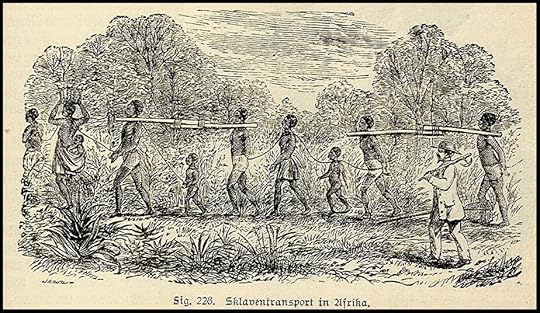
A Sketch of PORTUGUESE Slavers in Africa Transporting Native People
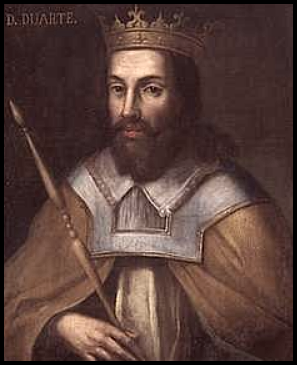
Portuguese King DuartE would Legalize slavery And Immensely Profit from the TransAtlantic Slave Trade
“The first example we have of Africans being taken against their will and put on board European ships would take the story back to 1441…when the Portuguese captured 12 Africans in Cabo Branco…and brought them to Portugal as enslaved peoples.”ii Under the reign of King Duarte of Portugal this first act of enslavement was followed by a public sale of African slaves in 1444 and by 1482 the Portuguese were constructing their first permanent slave trading post in modern day Ghana.iii Imperial Portugal would establish the first slave trade’s transatlantic bases and designed key trading ports to facilitate and expand its profits. These actions would generate massive labor power for the Portuguese while simultaneously displaying the wealth those who did not value all human life might acquire using oppression.

A Drawing of the SPANISH Massacre of the Taino Queen Anacaona and Some of her people following resistance to Spanish Domination and Enslavement of their Society
The rise of the Spanish monarchs Ferdinand of Aragon and Isabella of Castile would lend imperial Spain the power to expand its colonial holdings in the United States. Yet these new spacious areas required a huge labor force that Spanish nobles and conquistadores were not willing to pay. The supposed deep religious observance of imperial European powers based upon religious texts which justified the slavery of non-believers, something common to all the Abrahamic religions, was offered to begin the mass bondage of native peoples in America and eventually Africa. “For many Catholics, Popes included, slavery provided the rescue or salvation Africans needed. Not only would African souls be saved, but the Spanish kingdom would benefit as well from the commerce in human bodies…Spaniards and the Portuguese had become accustomed to financing their wars and expeditions by seizing men, women, and children whenever possible.”iv
Christopher “Columbus established the first European colony in the Americas in the island of Hispaniola (present day Haiti and the Dominican Republic). Columbus is believed to have had prior experience trading in West Africa, and had certainly visited the Canary Islands, where indigenous people know as Guanches had long been enslaved and exported, in small numbers, back to Spain. Though Columbus was primarily interested in finding gold, he also recognized Caribbean islander’s potential value as slaves.” Despite some uninformed modern claims slavery is not a capitalist invention but imperial command economy creation within North America that was established by Spain and fueled by Portuguese slave trade posts to oppress native populations around the world. Columbus would send five hundred Taino native slaves from the Caribbean to Spain in fourteen ninety-five, over a century before other European nations would emulate the Spanish imperial slave complex. Only three hundred of the Taino survived. While the Spanish monarchs would years later attempt to compensate the remaining Tainos, Spanish colonists ignored these reforms in several portions of North and South America by using mass slavery to fuel the development of their colonial infrastructure. This expansive infrastructure that heavily employed slavery would in time extend from “California to Buenos Aries”.v vi vii
Despite imperial “attempts” at reforming slavery the Spanish monarchs allowed colonial leaders feudal dominion over their “subjects” which included “compelling native populations to pay tribute, often in the form of labor” similar to Native American bondage of opposing tribes.viii While the Spanish crown claimed to oppose the transatlantic slave trade of Native Americans “the Crown permitted the outright enslavement and sale within the Americas. During the first half of the sixteenth century, Spanish colonists conducted raids throughout the Caribbean, bringing captives from Central America, northern South America, and Florida back to Hispaniola and other Spanish settlements. One of the “principal arguments” justifying “the enslavement of Amerindians” was the concept “of ‘just war’ (i.e. the notion that anyone who refused to accept Christianity, or rebelled against the Spanish rule, could be enslaved).”
Following additional later reforms adopted in the wake of irreparable damage to Native American populations the Spanish began “to look elsewhere for laborers long before the 1540s. With the Portuguese slave trade thriving, they increasingly looked to Africa.”ix One letter that written during 1501 by the Spanish monarchs to one of their agents states that travel by non-Catholics and the recently converted to their American colonies would be prohibited except in the case of “black slaves, or other slaves, that have been born under the dominion of our natural Christian subjects”. Spanish military leader and Governor of the West Indies Nicolas de Ovando oversaw “the trans-Atlantic slave trade to the Americas when he imported black slaves from Spain to the island of Hispaniola.” Consequently, despite the modern claims of some in academia, it was not the white English colonists who established and expanded slavery in the American continents but the imperial dictates of Spain.x Not only do the historical facts, trade papers, and royal decrees support this chain of events but even the bones of African slaves under Spain provide supporting forensic evidence of this historical period.

A painting of an African Slave Beaten publicly before a Crowd in BRAZIL
The Spanish would deem African slaves “negros” and commenced using them to replace the decreasing Native American populations in their quest for financial enrichment. “The King was even more ambitious than Ovando about using slave labor to increase gold production” and in just five years they “proved so effective that Ovando had 250 more slaves transported from Europe to work in the gold and copper mines.” Subsequently in 1518 the Spanish Holy Roman Emperor Charles the V would issue a charter “allowing four thousand Africans to be purchased directly from the Portuguese traders in the Cape Verde Islands and transported to the New World.” Spain’s first slave vessels would reach the Americas amid the 1520s and “expanded over the following decades, with the Spanish crown selling ‘licenses’ for specific numbers of slaves to individuals who would either arrange a slaving voyage, or attempt to make a profit by reselling the same license to a third party.” Clearly the legalized and entrenched system of human bondage in the New World was established to serve the imperial dominions of Portugal and Spain. This system of institutionalized human bondage was developed for centuries by imperial powers using slavery for profit in North and South America.
For Spain’s mass enslavement of Native Americans and Africans, establishing the European slave trade complex, and depriving untold future generations of their freedom King Ferdinand and his agent Columbus who filled the Church’s coffers with untold stolen riches were made saints. Queen Isabella’s beatification was denied because of her reported laws enacting the legal expulsion of many native groups who did not convert to Catholicism from Spain at the end of the Reconquista. Yet for some reason these foundational events leading to greater amounts of oppression and injustice within both American continents are left out of some modern assessments. No matter the basis of the historical omission, any future revisions are likely to be reasonably challenged and hopefully dispelled by those who are willing to offer more of the facts without relying on mere ideology.
Sincerely,
C.A.A. Savastano
References:
i. Indian Slavery in the Americas, AP US History Study Guide, The Americas to 1620: 1491-1607, The Gilder Lehrman Institute of American History, ap.gilderlehrman.org
ii. Crystal Ponti, August 14, 2019, America’s History of Slavery Began Long Before Jamestown, History, history.com
iii. Chronology- Who banned Slavery when?, March 22, 2017, Reuters, reuters.com
iv. Africans in Spanish America, History 301, Saylor Academy, resources.saylor.org
v. Slavery and Spanish Colonization, 2019, University of Houston, digitialhistory.uh.edu
vi. Martin Macias Jr, April 30, 2020, Bones Tell the Story of African Slaves in Spanish Colonies, Courthouse News Service, couthousenews.com
vii. Alex Borucki, David Eltis, and David Wheat, April 6, 2015, Atlantic History and the Slave Trade to Spanish America, Oxford Academic Journals, Oxford University Press, academic.oup.com
viii. Colonial enslavement of Native Americans included those who surrendered, too, February 15, 2017, Brown University, brown.edu
ix. Lowcountry Digital History Initiative, The Spanish and New World Slavery, College of Charleston, ldhi.library.cofc.edu
x. American Beginnings: 1492-1690, Toolbox Library: Primary Resources in U.S. History & Literature, National Humanities Center, nationalhumantiescenter.org



